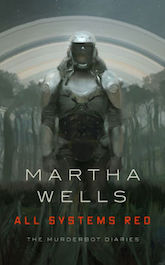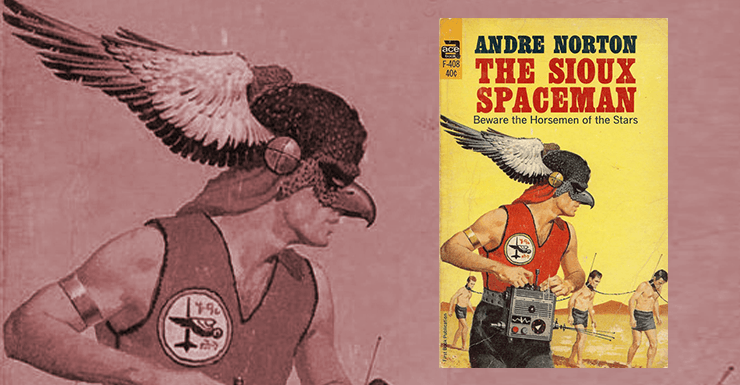I opened this book with trepidation, fearing it would be another misfire in the mode of The Defiant Agents. The cover copy of the edition I have is not encouraging. “…He alone, because of his Indian blood, had the key…”
Ouch. No.
Fortunately, while there are definitely elements of its time—in this case, 1960—the novel itself is a lively and enjoyable adventure. The racial determinism is relatively low-key, and the take on colonialism is surprisingly self-aware. This is no Defiant Agents (thank god). It reminds me much more of the Beast Master books.
Terran Space Service man Kade Whitehawk has screwed up royally in his last posting, but to his shock, he’s given a promotion: He’s assigned to a Mixed Team on the planet Klor. The team runs a trading post on a planet ruled by the alien Styor, whose galactic empire is fading. Kade hates the Styor. Really, really hates them.
Klor has intelligent native life, the Ikkinni. The Styor keep them as slaves and control them with mechanical collars. The Terrans lease some of these from a local lord and treat them as decently as possible, but freeing them is not an option.
Kade comes in as an outsider. His predecessor was of the same ethnicity as Kade, a North American Indian, and he was even of the same tribe, which is a truly remarkable coincidence. He was killed by violence; part of Kade’s job is to find out what happened.
Kade does quite a bit more than that. He finds that his predecessor, Steel, was researching Klorian grasses, and had sent a sample for testing. It comes back just as Kade arrives, as suitable for Terran livestock.
Buy the Book


All Systems Red: The Murderbot Diaries
One of the Styor lords has a thing for exotic animals. He’s imported a bear for his menagerie; Kade helps to deliver the animal. As he does so, he catches on to what Steel was planning.
It’s the same thing Kade is thinking. That the Plains tribes held off white colonizers for years with the help of horses stolen from Spanish invaders or else gone feral from the colonial herds. (The Spanish are the villains here. Northern European and British colonists, not so much. The book is of its time, after all.) This world has no such animals. But if it did, what might the Ikkinni do with them? Might the furred, more or less mammal-like natives fight off the evil reptilian Styor and win their freedom?
Kade gets one sharp check which impressed me, from a biologist who points out that the introduction of a non-native species might be an ecological disaster. This was written in the era of technology-conquers-all, though the environmental movement was just starting to gain traction. Kade, like most people in 1960 (and for that matter all too many of them in 2018), plows on past and imports a stallion and six mares.
Supposedly the horses are meant for the Styor collector, but the situation on the planet heads rapidly downhill. The Trade Post is destroyed by the Styor; Kade just happens to be off base at the time, and a couple of other Terrans manage to take shelter in a bunker and survive.
Kade tries to get to the bunker, but he can’t get near it before the rescue ship has come and gone. He’s exiled in the outback with a hostile native guide and his herd of horses. His attempt to interest the Ikkinni in the horses has failed: they’ve been fed propaganda that depicts the offworld animals as demons come to destroy the natives.
He discovers completely by accident that Terran stunners, under the right conditions, can shatter slave collars and free their wearers. The cost is high; not all Ikkinni survive the process. But the Ikkinni as a culture believe that, to cite a later and different fictional universe, the needs of the many outweigh the needs of the few. It’s better to die than remain enslaved, and if some don’t survive, the freedom of the rest is worth it.
The Ikkinni now have a goal: to get hold of as many stunners as possible. And, gradually, they come to see the value of the horse. Its speed and its ability to carry weight can change their world as it did that of the North American Indians.
Kade walks a narrow and precarious line with his sometime allies and sometime enemies, while also trying to figure out what happened to the Post and how to let his people know he’s still alive. He’s the catalyst for a slave rebellion that could make life very uncomfortable on this planet. Norton handwaves the larger consequences: This is a fringe world, the empire has bigger problems, there’s unlikely to be a massive wave of enforcers from offworld. The Ikkinni just might win.
He’s not supposed to be doing any of this, as far as he knows. In fact he expects his next posting to be a labor camp.
But when he finally reconnects with the Service, he discovers that he’s been an unwitting agent of a long term Terran plan to destabilize the Styor empire. This, like his previous posting, is a job interview. Instead of being a screw-up with his open antipathy toward the Styor and his ongoing sabotage of Styor rule, he’s just the kind of man the Service wants.
That’s a happy ending for Kade. The Ikkinni have a chance at freedom, and eventually (very much so considering the equine birthrate of one foal per mare per year, though the Service indicates that it intends to send more horses to Klor) driving the Styor off the planet. Which suits the Terrans perfectly. They’re playing a long game, with the goal of bringing down the evil slavelords.
There is a fair amount of “racial memory” in play here, but it’s mitigated by Kade’s knowledge of history and his solidly practical approach. He is a kind of “brown savior,” but it’s clear the Ikkinni have their own ways of dealing with what he has to offer. They’ll take it and run with it, and they won’t let themselves be trapped into slavery again.
The ecological question could become a major issue as the horse population increases, but in Kade’s calculus, whatever frees the Ikkinni and gets rid of the Styor has to be worth it. Norton doesn’t take that as far as she might, but she has other priorities and an inflexible word count.
Of course I have to talk about the horses. You knew that, right?
I had never pegged Norton as a horse person. The vast majority of her books either slide past the riding animals or give them a minimal role in the narrative. Here they’re crucial to the plot, and Kade spends a great deal of time having adventures with them.
They’re done surprisingly well. I don’t think she ever did any long-distance riding (or much if any riding at all) or she would have mentioned certain details about what happens when a person hasn’t ridden in a while; and she doesn’t make enough of the difficulty of teaching an adult non-rider to ride. She makes the classic mistake of having her rider “knee” the horse to make it go (it’s the lower leg that does it).
And yet, in other ways, she clearly did her homework. She selects a good equine type for this alien environment, the small, hardy horse of the East Asian steppes from Kazakhstan to Mongolia. It’s not the more gracile and aesthetic animal of the American Plains, but it can survive under difficult conditions, and it’s smart and tough and can, when it needs to, think for itself.
She knows (as many didn’t in 1960 and many don’t even now) that the lead mare is in charge of the herd and the stallion is its defense force. She gives both horses personalities and responsibilities, and shows how Kade respects their decisions when the situation gets complicated.
The rest of the mares are basically extensions of the leader, but that’s all right. The story doesn’t need any more than that. It’s a good example of a non-horse person writing a horse-centered story well enough to make it work.
This is a pretty good adventure overall, with a character who, if not tremendously engaging, is decently enough drawn to get the job done. The political and social setup took quite a bit of thought, and the Ikkinni are just enough different from Kade’s culture and mores to offer both friction and contrast. It’s a far better book than I expected. I actually enjoyed it, and would read it again.
I’m off to Eye of the Monster next, forewarned that it might not be quite as comfortable a read as The Sioux Spaceman. I’m prepared. We’ll see what happens.
Judith Tarr’s first novel, The Isle of Glass, appeared in 1985. Her most recent novel, Dragons in the Earth, a contemporary fantasy set in Arizona, was published by Book View Cafe. In between, she’s written historicals and historical fantasies and epic fantasies and space operas, some of which have been published as ebooks from Book View Café. She has won the Crawford Award, and been a finalist for the World Fantasy Award and the Locus Award. She lives in Arizona with an assortment of cats, a blue-eyed dog, and a herd of Lipizzan horses.










